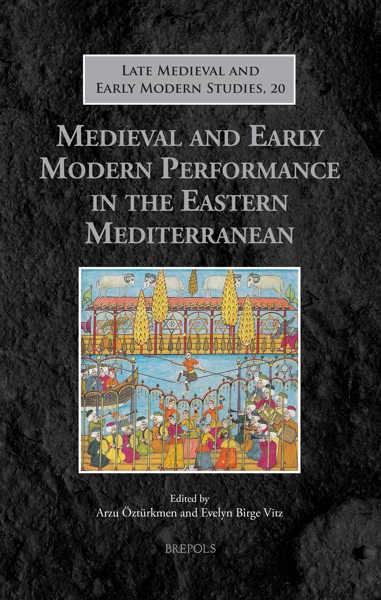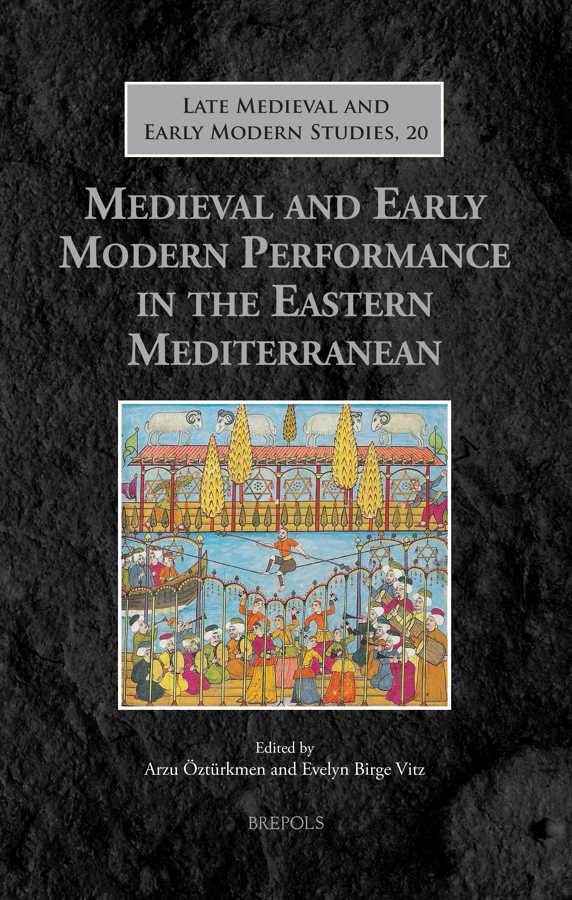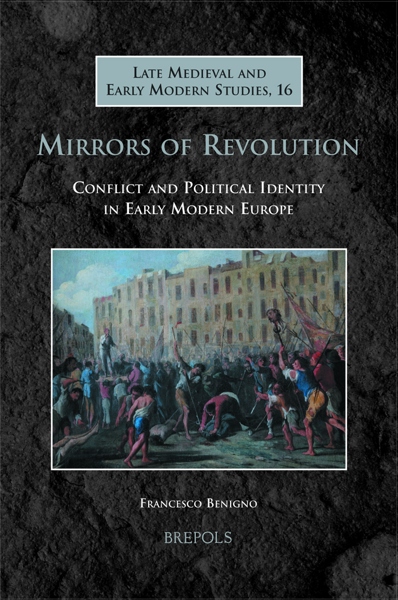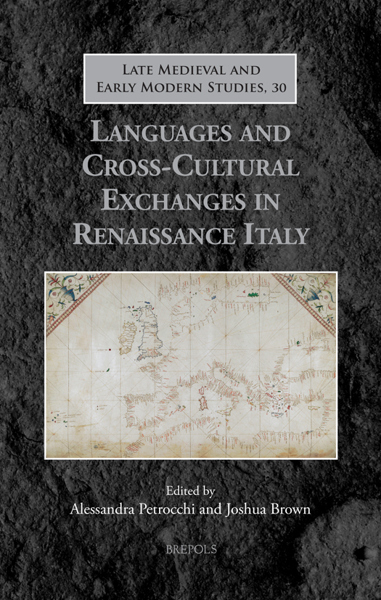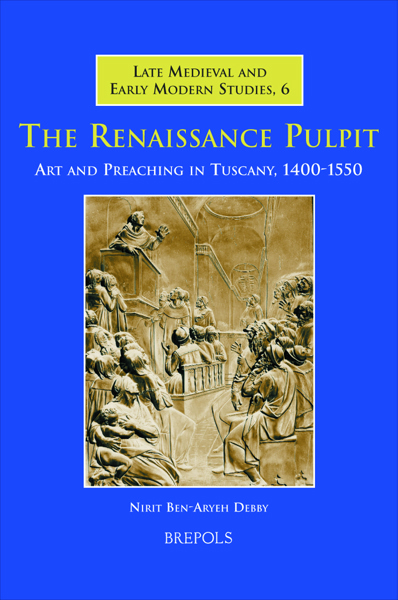
Medieval and Early Modern Performance in the Eastern Mediterranean
Arzu Öztürkmen, Evelyn Birge Vitz (eds)
- Pages: 576 p.
- Size:156 x 234 mm
- Illustrations:82 b/w
- Language(s):English, Latin, Greek
- Publication Year:2014
- € 155,00 EXCL. VAT RETAIL PRICE
- ISBN: 978-2-503-54691-9
- Hardback
- Available
- € 155,00 EXCL. VAT RETAIL PRICE
- ISBN: 978-2-503-54739-8
- E-book
- Available
An exploration of traditional performances in the Eastern Mediterranean in the medieval and Early Modern periods.
"This collection is ambitiously large, and the editors have done yeoman's work in keeping it thematically coherent, at least within the individual sections; some of the essays are exceptional in their reach and originality, and overall Medieval and Early Modern Performance in the Eastern Mediterranean will have a place as a general reference to the state of the field of historical performance studies." (Anna Linden Weller, in: The Medieval Review, 15.10.22)
"Medieval and Early Modern Performance in the Eastern Mediterranean is a very large book with a wealth of articles, and it is difficult to do them justice in a review. (...) In general, the book is an important contribution. I found it useful to my own work and can confidently recommend it to scholars in folklore, as well as to historians and specialists in related disciplines." (Natalie Kononenko, in: Journal of Folklore Research. Review posted on March 18, 2015; http://www.jfr.indiana.edu/review.php?id=1841)
"This volume is truly a gem. The scholarship is well organized, deftly written, and I can say in earnest that every single contributor has made a contribution in the truest sense of the word. (...) I would have to stress that the reader should continue reading from essay to essay in this volume without putting it down, as there is a flow of argument no doubt intended by the editors. On that, I congratulate them. This is a novel volume of essays that addresses sociopolitics, social cognitive nuances, literature, and artistic expression in an accessible manner; a great read for those who are interested in the abovementioned subjects and those enthusiastic about learning about topics that I dare say are rarely investigated." (Alireza Korangy, in: Renaissance Quarterly 69, 1, 2016, p. 348-350)
«Cet ouvrage collectif réunit une somme impressionnante d’études traitant des différentes formes de performances qui construisent et reflètent la culture d’une région particulièrement complexe, la Méditerranée orientale, depuis le temps des croisades jusqu’à l’ère ottomane» (C. Heering, dans le Bulletin Codicologique Scriptorium, 2, 2015)
This book brings to life an impressively broad array of performances in the Eastern Mediterranean. It covers many traditional types of performance, including singers, dancers, storytellers, street performers, clowns, preachers, shadow-puppeteers, fireworks displays, and semi-theatrical performances in folk and other celebrations. It explores performance of the secular as well as of the sacred in its many forms, including Sunni, Shiite, Sufi, and Alevi Muslims; Sephardic Jews and those in the Holy Land; and Armenian, Greek, and European Catholic Christians. The book focuses on the Medieval and Early Modern periods, including the Early Ottoman. Some papers reach backward into Late Antiquity, while others demonstrate continuity with the modern Eastern Mediterranean world.
The articles discuss evidence for performers and performance coming from archival sources, architectural and manuscript images, musical notation, historical and ethnographic accounts, literary works, and oral tradition. Across the broad range of issues, chronology, and geography, certain fundamental topics are central: concepts of drama and theatricality; varied definitions of ‘performance’ and related terms; the sacred and the profane, and their frequent intersection; and complex relations between oral and written traditions.
Introduction
Part 1. Verbal Art as Performance
Metin And
Storytelling as Performance — METIN AND
The Maqama — Between a Tale and a One-Man Show: In Search of its Form of Performance — REVITAL REFAEL-VIVANTE
Orality, Text, and Performance in the Book of Dede Korkut — ARZU OZTURKMEN
Signals of Performability in the Croatian Glagolitic Legend of St John Chrysostom — MARIJA-ANA DURRIGL
The Performance of Joinville’s Credo — MICHAEL CURSCHMANN
Medieval Folktales, Modern Problems, and a Gifted Preacher:The Case of Rabbi Joseph Hayyim and the ‘Tale of a Fox that Left his Heart at Home’ — DAVID ROTMAN
‘The Seven Sleepers of Ephesus’: Can We Reawaken Performance of this Hagiographical Folktale? — EVELYN BIRGE VITZ
Part 2. Performance under Imperial Realms
How to Entertain the Byzantines: Some Remarks on Mimes and Jesters in Byzantium — PRZEMYS ŁAW MARCINIAK
Between Admiration, Anxiety, and Anger: Views on Mimes and Performers in the Byzantine World — TIVADAR PALAGYI
Performance and Ideology in the Exchange of Prisoners between the Byzantines and the Islamic Near Easterners in the Early Middle Ages — KORAY DURAK
Fireworks in Seventeenth-Century Istanbul — SURAIYA FAROQHI
Clowns at Ottoman Festivities — OZDEMIR NUTKU
Lady Mary Wortley Montagu (1689–1762): Her Turkish Performances — DANIELLE HAASE-DUBOSC
The Fusion of Zar-Bori and Sufi Zikr as Performance: Enslaved Africans in the Ottoman Empire — EHUD R. TOLEDANO
Part 3. Modes and Varieties of Entertainment
How Dark is the History of the Night, How Black the Story of Coffee, How Bitter the Tale of Love: The Changing Measure of Leisure and Pleasure in Early Modern Istanbul — CEMAL KAFADAR
One Man and His Audience: Comedy in Ottoman Shadow Puppet Performances — DARYO MIZRAHI
Shadow Theatre, the Karagoz (Kara Gyooz) and the Texts of Ibn Daniyal (1248–1311?) — MAS ’UD HAMDAN
Armenian Traditional Music and the Performance Practices in the Armenian Community of Jerusalem — NOUNE ZELTSBURG-POGHOSYAN
Constructing the Performed Identity of Sephardic Songs — JUDITH R. COHEN
Gypsy Musicians and Performances in the Ottoman Balkans — ELENA MARUSHIAKOVA and VESSELIN POPOV
Part 4. Iconography
Scenes of Performers in Byzantine Art, Iconography, Social and Cultural Milieu: The Case of Acrobats — VIKTORIA KEPETZI
Theatricality of Byzantine Images: Some Preliminary Thoughts — ANESTIS VASILAKERIS
Theatrical Features in Armenian Manuscripts — EMMA PETROSYAN
Capital Initials with Images of Musicians in Armenian Manuscripts — HRANT KHACHIKYAN
Glorious Noise of Empire — GABRIELA CURRIE
Part 5. Ritual Roots of Performance
Representing the Moulid: Salah Jahin’s Al-Layla al-Kabira between Populist and Nationalist Aspirations — SAMIA MEHREZ
Performative Conceptions of Social Change: The Case of Nevruz Celebrations in Pre-Ottoman and Ottoman Anatolia — YUCEL DEMIRER
Alevi Ritual Movement:Its Representation in Fifteenthand Sixteenth-Century Texts and Today — FAHRIYE DINCER
The Moreška Dance/Drama on the Island of Korčula (Croatia): A Turkish Connection? — ELSIE IVANCICH DUNIN
The Show and the Ritual: The Mevlevi Mukabele in Ottoman Times — CEM BEHAR
The Ritual of Vardan Mamikonyan — ZHENYA KHACHATRYAN
Epilogue: The Performative Turn in Recent Cultural History — PETER BURKE
Index
